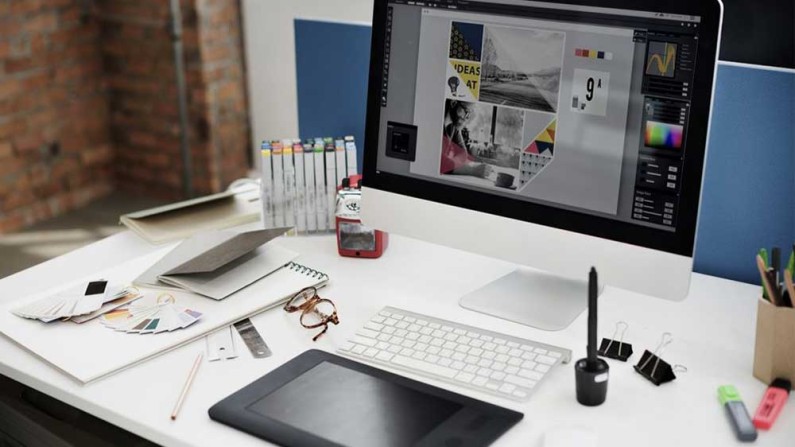Why Graphic and Web Designers Are Still Relevant: A Deep Dive

In today’s digital age, it might seem like graphic and web designers are becoming less relevant. After all, with the rise of DIY design tools and advanced AI technology, you might wonder why anyone would need a human designer. But let’s take a closer look at why graphic and web designers are still very much in demand and essential for creating truly standout visuals and experiences.
“Design is thinking made visual” (Saul Bass)
Designers takes conceptual thoughts and render them into visual forms (graphics, layouts, and interfaces) that can be seen and understood. This visual representation bridges the gap between complex ideas and effective communication, solving problems and engaging audiences. Through design, intangible thoughts are made concrete and accessible, allowing for clear expression and emotional connection.

The Human Touch: Creativity and Innovation
First and foremost, let’s talk about creativity. Sure, AI and design tools can churn out designs quickly and efficiently. They can generate color palettes, suggest layouts, and even create logos. But creativity isn’t just about putting elements together; it’s about pushing boundaries and thinking outside the box.
Graphic and web designers bring a level of creativity and innovation that goes beyond what an algorithm can offer. Designers can interpret complex ideas, understand subtle nuances, and infuse personality and emotion into their work. They don’t just follow rules, they bend them to create something truly unique. When you’re working with a designer, you’re not just getting a product; you’re getting a piece of art that’s crafted with a deep understanding of your brand’s essence and goals.
The Brand Identity Factor
Let’s consider branding for a moment. Your brand identity is crucial, it’s what makes you recognisable and relatable. Graphic and web designers are experts in crafting visual identities that communicate your brand’s message and values. They create logos, color schemes, typography, and other elements that form the visual backbone of your brand.
A designer’s job is not just to create something that ‘looks good’; it’s to ensure that every element aligns with your brand’s voice and vision. This involves a lot of strategic thinking. For instance, a designer will consider how different colors evoke emotions, how typography affects readability, and how various design elements work together to create a cohesive look. This kind of thoughtful, strategic approach is something that’s tough to replicate with automated tools.
User Experience and Functionality
Now, let’s talk about user experience (UX) and functionality. When it comes to web design, it’s not just about how a site looks but also how it works. Graphic and web designers are skilled in creating user-friendly interfaces that are intuitive and engaging. They think about the user journey, ensuring that visitors can navigate your site smoothly and find what they need without frustration.
Designers also consider factors like page load times, mobile responsiveness, and accessibility. They can anticipate user behavior and make design decisions that enhance the overall experience. While there are tools that can help with these aspects, they often lack the nuanced understanding of user behavior and design principles that a human designer brings to the table.
Personal Client Interaction
Another big advantage of working with a designer is the personal touch. Design is a collaborative process, and having a designer means you get to work closely with someone who understands your vision and can adapt to your feedback. This personal interaction allows for a level of customisation and refinement that automated tools can’t offer.
With a designer, you get a partner who listens to your ideas, asks the right questions, and translates your vision into reality. This back-and-forth communication ensures that the final product aligns with your expectations. It’s a process that’s both iterative and adaptive, allowing for tweaks and changes along the way.
Professional Expertise
Let’s not forget the professional expertise that graphic and web designers bring. These professionals are trained in design principles, software, and industry standards. They stay up-to-date with the latest trends and technologies, ensuring that their work is not only visually appealing but also current and effective.
Designers understand the importance of things like image resolution, file formats, and scalability. They know how to create designs that look great on different devices and platforms. This kind of technical know-how is crucial for producing high-quality work that performs well in real-world applications.
Quality Control and Consistency
Consistency is key in design, especially when it comes to branding and user experience. Graphic and web designers excel at maintaining consistency across various touchpoints. Whether it’s a website, social media, print materials, or advertisements, designers ensure that all elements work together harmoniously. This attention to detail helps create a cohesive brand experience. Inconsistencies in design can confuse customers and dilute your brand’s message.
Designers help avoid these pitfalls by applying consistent design principles and adhering to brand guidelines.
Navigating Trends and Technology
Design is a field that’s always evolving, and keeping up with trends and technology is part of a designer’s job. They are adept at integrating new tools and techniques while maintaining a focus on timeless design principles. This ability to balance the latest trends with fundamental design skills ensures that their work remains relevant and effective.
For instance, designers might incorporate cutting-edge interactive elements or stay on top of colour trends, all while ensuring that their designs are user-friendly and align with your brand’s identity. They can navigate these changes with skill, ensuring that your designs are both contemporary and enduring.
The Emotional Connection
Finally, let’s consider the emotional impact of design. Good design does more than just look nice, it resonates with people on an emotional level. It can evoke feelings, inspire action, and create a lasting impression.
Graphic and web designers understand how to use visual elements to forge these emotional connections. They tap into human psychology, using color, imagery, and layout to create a response from your audience. This emotional connection is powerful and can significantly influence how people perceive and interact with your brand.
Conclusion
So, there you have it! Despite the advancements in technology and the availability of DIY design tools, graphic and web designers remain as relevant as ever. Their creativity, strategic thinking, and technical expertise ensure that designs are not only visually stunning but also effective and aligned with your brand’s goals.
Working closely with a professional designer means you get a personalised, high-quality product that stands out and resonates with your audience. In a world where design plays a crucial role in shaping perceptions and driving engagement, having a skilled designer on your team is more valuable now than ever.
